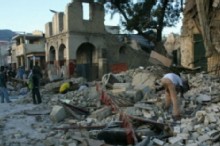The eventual death toll in the massive earthquake that struck Haiti on Jan. 12 will be unbearable. Haitian Prime Minister Jean-Max Bellerive warned CNN that by Wednesday, hundreds of thousands of people could have died. But while emergency response teams have already begun combing through the wreckage, searching for injured who might still be saved and treating wounds to prevent infection, there are longer-term health risks that threaten the devastated island. With basic health care and sanitation all but destroyed, and millions of survivors likely left in homeless, unchecked infectious disease and contamination will pose a threat to survivors. "In the weeks to come we may have huge issues with public health," says Pino Annunziata, who is coordinating the emergency response for the World Health Organization in Geneva. "This will be a major concern."
It doesn't help that even on its best day, Haiti is a public health disaster. It is one of the poorest countries on Earth, with only one in every 50 Haitians holding a steady job. No Haitian city has a public sewage system, and less than half the population has any access todrinking water services. Malnutrition is rampant, nearly 200,000 people live with HIV or AIDS and just half the childhood population is vaccinated against basic diseases like diphtheria. The quake will make it all unimaginably worse. "Haiti is not anywhere near ready to take care of itself," says Dr. Alina Dorian, the assistant director of theUniversity of California-Los Angeles Center for Public Health and Disasters. "They are already so vulnerable." (See pictures from the quake's aftermath.)
That vulnerability will be felt first in the water. In a major disaster, time is of the essence, and survivors will succumb to thirst and dehydration much faster than malnutrition. With drinking water distribution systems destroyed - and survivors crammed into camps without much sanitation - water supplies could quickly become contaminated. That can lead to rapidly spreading water-borne diseases like cholera and dysentery, which can sweep through refugee camps. (In the 1994 Rwanda refugee crisis, cholera took some 45,000 lives in less than three weeks.) That, in turn, puts emergency responders in a race against time - shipping in clean water or purifying existing supplies before diseases start spreading. And it's not just drinking water that will be in demand. Latrines need to be set up quickly to prevent contamination. "It's called WatSan - water and sanitation," says Patrick McCormick, a spokesperson for UNICEF. "That will be the key." (See the top 10 medical breakthroughs of 2009.)
The next danger will be existing infectious diseases that might attack survivors - especially in the cramped and less than hygienic conditions of a refugee camp. Measles and other childhood infections will be particularly worrying, especially since nearly half of Haiti's population is under the age of 18, and many are already in poor health. Doctors will need to launch vaccination drives to protect the vulnerable and do so fast. In past disasters, like the 2004 Asian tsunami, lack of vaccinations before the event had a major impact on the spread of diseases after it. Above all, medical teams will need to establish quick surveillance to identify health needs and pinpoint incipient outbreaks before they explode. "Getting accurate information in the midst of chaos is really of prime importance," says Dr. Ronald Waldman, a clinical epidemiologist at the Mailman School of Public Health at Columbia University and a veteran of the 2004 tsunami response. "That needs to be the first thing." (See where the next five big earthquakes will be.)
The good news is that we now rarely see major outbreaks of infectious disease in the wake of natural disasters. Contrary to the popular myth, dead bodies aren't major conduits for disease, and even in the case of disasters in relatively isolated countries - like the cyclone that hit Burma in 2008 - the death toll from disease following the catastrophe was smaller than feared. That was true of the 2004 tsunami as well, as a rapid and thorough response headed off what could have been a huge post-disaster death toll. "That fear of disease is often overplayed," says Dr. Demetrios Pyrros, the president of the World Association for Disaster and Emergency Medicine. "It's going to be important to deal with people's day to day injuries." (See TIME's photo-essay about the 2004 tsunami.)
Still, Haiti will be a huge public health challenge. The high prevalence of chronic diseases - such as HIV and TB - means that doctors will need to ensure a steady supply of drugs in order to prevent long-term treatments from being interrupted. The sheer amount of international attention on Haiti in the wake of the quake might ultimately improve its public health system - as occurred in Aceh after the tsunami. As challenging as the next few days in Haiti will be, responders will also need to start planning for the future quickly. "You need to start thinking 10 days, a month, six months down the line," says Waldman. "If so, we can hope that all the deaths will occur from the quake will have already occurred."
View this article on Time.com
Related articles on Time.com:








![Newsies [Region 2]](http://ws.amazon.com/widgets/q?MarketPlace=US&ServiceVersion=20070822&ID=AsinImage&WS=1&Format=_SL160_&ASIN=B0001NIYRW&tag=khmerf-20)



No comments:
Post a Comment